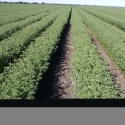30 Jun 2015
Response to deep placed P, K and S in central Queensland
Summary of six crop years
 Poor patches in wheat due to low K
Poor patches in wheat due to low K
Two field experiments were established in central Queensland at Capella and Gindie to investigate the immediate and then residual benefit of deep placed (20 cm) nutrients in this opportunity cropping system. The field sites had factorial combinations of P (40 kg P/ha), K (200 kg K/ha) and S (40 kg S/ha) and all plots received 100 kg N/ha. No further K or S fertilizers were added during the experiment but some crops had starter P. The Capella site was sown to chickpea in 2012, wheat in 2013 and then chickpea in 2014. The Gindie site was sown to sorghum in 2011/12, chickpea in 2013 and sorghum in early 2015.
The site soil test values are shown in Table 1.
| unit | Gindie | Capella | |||
| Analyte | 0-10 cm | 10-30 cm | 0-10 cm | 10-30 cm | |
| pH Ca | 7.2 | 7.8 | 8.1 | 8.3 | |
| CEC | cmol(+)/kg | 35.3 | 38.4 | 73.7 | 74.6 |
| OC | % | 0.6 | 0.5 | 0.7 | 0.7 |
| Colwell P | mg/kg | 13 | <5 | 10 | <5 |
| BSES-P | mg/kg | 10 | 5 | 14 | 9 |
| Ex-K | cmol(+)/kg | 0.17 | 0.07 | 0.46 | 0.16 |
| KCl-40 S | mg/kg | 3 | 2 | 3 | 2 |
| DTPA Zn | mg/kg | 0.2 | 0.1 | 0.3 | 0.1 |
There were responses to P alone in the first two crops at each site and there were K responses in half the six site years. In year 1 (a good year) both sites showed a 20% grain yield response to only to deep P. In year 2 (much drier) the effects of deep P were still evident at both sites and the effects of K were clearly evident at Gindie. There was a suggestion of an additive P+K effect at Capella and a 50% increase for P+K at Gindie. Year 3 was dry and chickpeas at Capella showed a larger response to P+K but the sorghum at Gindie only responded to deep K.
A summary of the results is given in Table 2.
| Site and crop/year | Control | K | P | S | PK | PS | KS | PKS | LSD (P<0.05) |
‘Stranraer’ Capella | |||||||||
| Chickpea 2012 | 2.33 | 2.34 | 2.75 | 2.32 | 2.89 | 2.79 | 2.30 | 2.83 | 0.17 |
| Wheat 2013 | 2.08 | 2.19 | 2.25 | 2.19 | 2.36 | 2.25 | 2.20 | 2.34 | 0.09 |
| Chickpea 2014 | 1.51 | 1.59 | 1.57 | 1.53 | 1.69 | 1.65 | 1.60 | 1.75 | 0.10 |
‘Bendee’ Gindie | |||||||||
| Sorghum 2011/12 | 2.32 | 2.39 | 2.78 | 2.36 | 2.90 | 2.81 | 2.35 | 2.81 | 0.14 |
| Chickpea 2013 | 1.15 | 1.47 | 1.32 | 1.21 | 1.74 | 1.18 | 1.52 | 1.61 | 0.26 |
| Sorghum 2014/15 | 2.94 | 3.40 | 2.99 | 2.90 | 3.38 | 3.25 | 3.19 | 3.25 | 0.20 |
Conclusion
Nutrients deep placed (20 cm), in this case P and K, showed responses over a range of crops and environmental conditions. Responses were more apparent in drier years where crop roots drew water and nutrients from the subsoils rather than from a larger soil volume. These responses were seen for at least three crops over four years, indicating the feasibility of deep placement at the start of a cropping cycle to meet nutrient demands in this opportunity cropping system.
A full report on this work will be presented at the Australian Society of Agronomy Biennial Meeting at Hobart, Tasmania, in September 2015.




